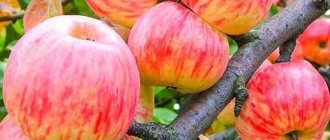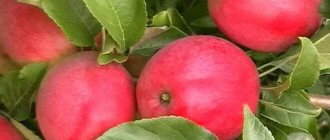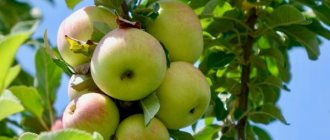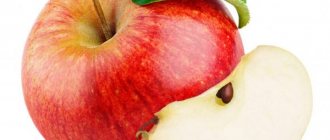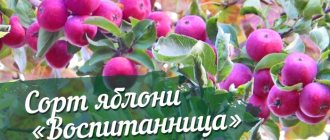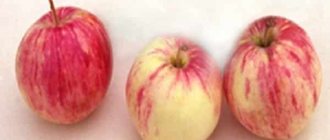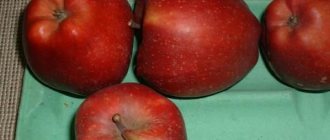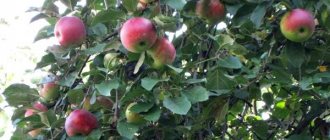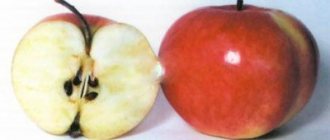Work on the creation of new varieties on the territory of the Russian Federation has been carried out for a very long time. Breeders are constantly working to create different varieties of apple trees that are suitable for climate types and terrain features. Orlovskoe striped is a variety that achieved success in the central zone and even became elite.
Apple tree variety Orlovskoye Polosatoye.
Characteristics
The Orlovskoe striped apple variety is widespread in the Central, Middle Volga and Chernozem regions. But gardeners say that with proper agricultural technology, apple trees can be successfully grown even in the Siberian regions.
Appearance
The apple tree is medium-sized, it has a beautiful rounded crown and dense, heavily leafy shoots. The leaves are large and have a bright green color. The apple tree blooms abundantly.
In the photo Orlovskoe striped in bloom.
Fruit
The size of the Striped apples is medium-large. They are one-dimensional, regular round in shape. The appearance is very attractive. The skin is thin, golden, with a purple blush in the form of blurred stripes, through which subcutaneous dots are visible.
Advantages and disadvantages
The advantages can be listed for a very long time. Among them:
- early fruiting of the variety;
- external and taste characteristics of fruits;
- good immunity to scab;
- big harvest;
- relatively autumn representatives have a long shelf life.
The disadvantage is the thin skin, which requires careful handling. Fruits must be removed carefully and avoid injury or falls.
Tree height and crown width
The maximum growth of the apple tree reaches 5 meters. The width of the rounded crown can reach a maximum of 4.5 meters.
Yield and tasting rating
The apple tree is considered one of the most productive. In comparison, only Jonathan ranks higher. On an industrial scale, about 200 centners per hectare are collected. In single orchards, up to 100 kg of fruit are harvested from a mature apple tree per season.
The taste of the pulp is sweet and sour, but it is the sourness that predominates in the taste. It contains a lot of ascorbic acid and sugars. In different sources, the tasting score varies from 4.2 to 4.6 points.
Winter hardiness
The variety is considered resistant to cold weather and survives long-term frosts in the middle zone. The Oryol region, according to its name, is also comfortable for growing.
There is confirmed evidence that the variety is cultivated in the northern regions. Here the Oryol striped apple trees are formed in a slate form and insulated as much as possible.
Apple tree in winter.
Disease resistance and lifespan
The variety has good immunity to scab. But this does not mean that there are no manifestations of fungus on it. It is necessary to carry out preventive measures and regularly inspect fruit crops on the site.
The lifespan of the common Oryol striped apple tree is 40 years. This figure can only be achieved with proper care. But it may decrease slightly depending on the rootstock, and also if the living conditions of the apple tree do not meet the necessary requirements.
Pollinator varieties
The variety is considered partially self-fertile. But in order to maximize the number of ovaries, it is necessary to plant varieties of apple trees nearby that bloom at the same time. The best pollinators are: Titovka, Papirovka, Striped and scarlet anise, Slavyanka.
Description of the variety Orlovsky striped
The tree of this variety is of medium height. The crown is extensive, round, with thick, flexible branches at the ends. The branches forming the crown extend at an angle of 90 degrees from the main trunk.
Trees in the middle zone tolerate frost well and have good yields.
Some apples are located on ring-shaped shoots grown on three-year-old branches. Others are placed on flexible two-year-old twigs. Branches are either growth or fruit-bearing.
The trees stretch up to 15 m, have a well-branched root system, and go 2.5 m deep.
The branches have large, convex buds. The leaves often grow, round in shape, with teeth along the edges, pubescent, growing thicker towards the end of the branches, on strong petioles, and deviate from the stem at a slight angle.
Large snow-white, cup-shaped flowers with soft pink buds adorn the tree in the spring, like a bride’s veil. The petals on the flowers are concave, round, and overlap each other at the edges. The powerful pistil is surrounded by stamens. The stigma of the sticky pistil is located just above the loose anthers.
The apples are large, painted with crimson-red stripes on a salad base background and noticeably lighter dots under the skin. During the period of full maturity, the main tone becomes yellowish. These apples are pleasant to the taste, sweet and sour and surprisingly aromatic. The pulp of apples is tender, white or pinkish, even creamy, fine-grained.
The stalks are short, straight, thin. The funnel is pointed and shallow. A deep saucer, with a slightly ribbed wall, the cup is closed, sometimes open. The heart is large. The seed chambers are open, the seeds are dark, indistinct in shape, and sometimes underdeveloped.
The shape of apples is round, slightly elongated, reminiscent of a trimmed cone or an ideal bun with a stem. The stalk is strong and brownish in color. The skin is thin, delicate, covered with a thin matte layer of natural wax. Requires careful handling during collection and storage for long-term storage.
The fruits begin to ripen by the beginning of September, although some gardeners classify it as late autumn. The average fruit weight is from 120 to 150 grams.
Landing
Proper planting of an apple tree is the key to normal development. Therefore, it must be carried out while observing several important rules.
Selecting a location
The apple tree prefers to grow in a place where it will be illuminated by the sun from all sides. In this case, it is better that the crop is not affected by strong gusts of wind. Lack of sun will negatively affect the sweetness of the fruit, and strong winds can break the shoots.
The process of planting an apple tree.
The fruit crop is also sensitive to moisture levels. It is necessary that the roots are at least two meters away from groundwater. With this risk, it is better to choose a planting site on a hill or make drainage.
The soil should be slightly acidic, closer to neutral acidity. It is best to plant Orlovskoye on sandstone or loam.
Seedling preparation
When purchasing a seedling, you need to pay attention to its condition. If purchased already with leaves, then they need to be removed. Even if a young tree has large and long roots, they cannot be cut or shortened.
Pit preparation
The planting pit is prepared in advance. The area where it will be located is cleaned and leveled. It should be roomy so that the roots have enough space. Organic matter, mineral fertilizers and wood ash are added to it along with fertile soil.
Deadlines
Planting can be carried out in two periods - in spring and autumn. Spring planting is carried out at the end of April, before the apple tree begins to actively grow. In autumn, planting is carried out two weeks before frost. Experts advise placing the Oryol striped plant in the ground at the beginning of October.
Technology
The boarding procedure is surprisingly simple. The seedling is simply placed in a hole, the roots are straightened and covered with soil. After the procedure, the apple tree is watered. The root neck should be left 5-6 cm on the surface.
Apple tree planting diagram.
Pruning and crown formation
the branches are cut by 1/3 first , then the tree will quickly establish a crown. The apple tree is pruned every year in April , so that the buds have not yet bloomed.
When completely pruning a branch, you should not leave a stump; cut off the branch at the base . They cut off those branches that, when loaded with apples, sink to the ground. When pruning young shoots, the strongest ones and those that stand straight are left, the rest are cut off.
General principles of pruning apple trees.
Attention! You can cut no more than ¼ of the total mass of branches, as otherwise the tree may die.
The following video will tell you how to properly trim an apple tree:
Annual apple trees
When purchasing an annual apple tree with bare roots, you should equalize the root system and the above-ground part. If this is required, then sanitary pruning is done on the part that is above the ground. The stem is cut at a height of 100 cm , this will stimulate the growth of lateral branches, which will subsequently become the skeletal branches of the first tier.
All buds and branches from the soil surface to the first tier of skeletal branches are cut off ; this will be the trunk area. A too low bole will make it difficult to loosen the soil and pick apples, while a too high bole can burn the sun.
Pruning an apple tree in the first three years.
If the tree has already grown branches, then first mark those that will be the first tier - these are 3-5 branches directed in different directions. If there is just a stem, then 5-8 buds are left, from which the first tier will be formed. And also the bud, which is located above them, it should be directed in the opposite direction from the bend in the budding zone, then the stem will be even.
A continuation shoot will grow from the topmost bud and will replace the leader shoot. The branches that are spaced from the trunk at an acute angle are trimmed, and the remaining ones are shortened.
Watch the video about the nuances of pruning an annual apple tree:
Growing
The apple tree is not considered particularly whimsical, but it responds very positively to care.
Agricultural technology
A necessary agrotechnical technique is fertilizing. In the first year it is not added, but in the second year organic matter is added to the tree trunk circle. Already from the third year, the amount of fertilizer should be full.
An important requirement is to regulate the number of ovaries. In the first year, you need to remove 90% of the flowers, leaving a few for testing. In subsequent years, you need to leave up to 50% of the ovaries, choosing the largest and most viable ones. It is important to do this so that the fruits are large and ripen sweet.
Watering
Young Orlovskoe striped trees need frequent watering. Every week you will need to add two buckets of water under the apple tree. Moreover, it is better to vary the amount, pouring one bucket in the morning and the second in the evening.
Loosening and pulling out weeds
It is important to keep the tree trunk clean so that pests do not settle in it and fungi do not multiply. To do this, be sure to remove all weeds. After watering the next day, it is necessary to loosen the soil. You can simplify these two matters by mulching. The covering material will retain moisture and prevent weeds from germinating.
Loosening the soil around the apple tree.
Preparing for winter
The variety is quite resistant to cold weather, but needs a little shelter for the winter. To do this, the tree trunk circle is insulated with rotted manure and covered with spruce branches. The trunk needs to be whitened and wrapped with insulation.
Beginning of fruiting
The variety is early bearing. The first fruits can be collected already 4 years after planting an annual tree.
Flowering period and fruit ripening period
The apple tree blooms quite abundantly, the inflorescences are large. They open in mid-May.
Fruit picking takes place in the fall. The number of fruits is large with proper care.
Removable maturity and shelf life of fruits
The fruits are ready to eat immediately after removal. The varietal feature of the apple tree - thin skin - implies a very careful procedure.
Apple harvest.
Fruits can be stored until approximately January. It is important to store them correctly: fold them carefully and provide high humidity and low temperature.
Pruning and crown formation
It is very important to carry out the first pruning immediately at the time of planting. All shoots will have to be cut by a third. This must be done so that the apple tree immediately begins to grow its crown.
Formative and sanitary pruning can be combined. The procedure is carried out in the spring, before the buds open. It is necessary to remove those shoots that thicken the crown, grow too close and interfere with others, look down and those that cross each other. It is important to use moderation and remove no more than a quarter of the total mass of shoots so that the apple tree does not get sick.
Collection and storage
Apple trees of this variety ripen and are ready for harvest from the beginning of September. The trees produce fruit consistently every year, starting at 4 years of age. The fruits must be collected carefully so as not to damage the thin skin.
Store at a maximum humidity of 60% and a temperature of 1–2 degrees.
You can keep apples fresh in boxes made of wood. To do this, the fruits are laid out in layers, each layer covered with cardboard. If there are few fruits, then each apple can be wrapped in newspaper. Orlovskoe striped apples can be stored under these conditions until January.
It is good to store fruits in the refrigerator, on a glazed balcony, or on a loggia.
Kinds
There are several varieties of growing Oryol striped, varying in size.
On a dwarf rootstock
Apple trees on a dwarf rootstock are mostly planted in places where groundwater is close. The peculiarity of such representatives is the superficial root system, which does not go deep, but is prone to freezing. The tree does not grow more than 2.5 meters and begins to bear fruit much earlier, in the second year.
Dwarf rootstock.
Caring for the dwarf Orlovskaya is the same as for a regular one; the properties of the fruit are preserved. It will only be necessary to pay attention to covering the tree trunk and protecting the thin bark from rodents.
On a semi-dwarf rootstock
Semi-dwarfs are grown at 3.5 meters and have a compact, rounded crown. They are preferably planted in the fall and well insulated. Before planting, it is important to fertilize the soil.
Apple tree on a semi-dwarf rootstock.
It is worth noting that semi-dwarfs need fertilizer and moisture more often than vigorous crops. But for watering in the first years it is better to use a drip system, and fertilize the next year after planting. At the same time, semi-dwarfs retain all varietal characteristics.
Planting and caring for an apple tree
For planting, it is better to take a three-year-old seedling. The height of the tree should be 1.6-1.8 meters. The root system must be strong, undamaged and healthy. Planting can be done both in autumn and spring. Before the onset of persistent frosts, the tree must have time to take root. Therefore, 2-3 months are counted from this time, this is the best time for planting. Planting times vary by region.
To grow the Oryol striped apple tree, moist, fertile, moisture- and breathable soil is required. The best place for planting is loamy, floodplain, sandy loam, leached chernozem. In a sandy area, the tree requires abundant watering and regular, intensive feeding.
The place should be bright and windless. Close passage of groundwater is detrimental to the tree. When planting, it is necessary to equip a good drainage system.
The acidity of the soil should be equal to 6 pH; if the values are exceeded, wood ash, slaked lime or dolomite flour are added to the soil.
The site for planting is selected in advance and prepared. The area is dug up and rotted humus is added. If the soil is clayey, sand is added; if it is sandy, on the contrary, clay is added. If planting is to be done in the spring, the hole is dug in the fall. When planting in autumn, the pit is prepared in the summer, a month before planting.
The gap between seedlings should be 4-6 meters. When regrafting onto low-growing trees, the distance should be 3-4 meters.
The diameter of the pit is 1 meter, the depth is 80-90 centimeters.
For planting, a nutrient mixture is prepared, for which the following is taken:
- turf or leaf soil (2 buckets),
- mineral (800 grams of superphosphate),
- organic fertilizers (2 buckets of humus and compost),
- peat (1 bucket)
- wood ash (1 kilogram).
Nitrogen fertilizers cannot be added during planting.
The mixture is mixed and fills the hole by a third. It should be a slide. A peg is driven in to tie up the tree.
The seedling is placed on a hillock, the roots are straightened and covered with soil mixture. The filled pit is watered abundantly with warm water. When subsidence occurs, more earth is poured in. The root collar after planting should be at a level of 5-6 centimeters from the ground. The tree is tied to a peg in a figure eight.
Care
The future harvest and health of the tree depend on the correct implementation of care activities.
Care includes:
- watering,
- pruning,
- feeding,
- weeding,
- loosening the soil
- shelter for the winter.
Watering should be done once a week. The tree needs 2 buckets of water, watering is carried out in the morning and evening. In July - August the volume of water increases. The soil should not become waterlogged or dry out.
To maintain moisture, the soil must be regularly weeded and loosened. After these procedures, the tree trunk circle is mulched with humus.
Trimming
The apple tree responds favorably to fertilizing and formative pruning. When forming a tree, the best option is a sparsely-tiered and vase-shaped crown type.
Sparsely tiered crown
The sparsely tiered crown has branches - tiers and a main central conductor. In the first year of growth, the crown is laid. The standard is indicated. Half a meter is measured from the ground and a mark is made. Then, another 30 centimeters are measured from the mark. Shoots growing above a developed bud are removed.
After a year, if new shoots form on the trunk, they must be removed. Of the branches remaining during the previous pruning, 3 branches are left above the level of the trunk. The lower branch should be at the level of half a meter from the ground, the others higher (at a distance of 15 centimeters from each other).
The branches should be located in opposite directions. Branches that grew at the site where the trunk was trimmed are removed. In a fully formed tree, the guide should go above the skeletal branches.
In the third year, a new tier is formed. From the first three branches you need to measure half a meter and lay two oppositely growing branches. Protruding parts on the tree are cut off. Competing, crooked shoots are removed. The growth on the conductor is shortened by several centimeters. When thickened, bent branches are shortened into a ring.
In the fourth year, the third tier is created. A new tier is formed at a distance of 45-50 centimeters from the previous one. The conductor is cut. Excess branches are cut into a ring, and the shoots are shortened.
Vase type
The vase-shaped type is composed of 3-4 skeletal branches. The branches form a tier on a trunk 40-50 centimeters high. The central conductor is cut out immediately, in the first year of pruning.
The main branches have 2 second-order branches and 4 third-order branches. The endings of the latter grow at the same level (horizontally). The distance from the base of the main branch to the second-order branch is 40-50 centimeters. From the first to the second branch of the main branch, the gap should be no more than half a meter.
Formation is carried out before the first fruiting. Then, annual (2 times a year) sanitary pruning of the tree is carried out.
Fertilizer
Any feeding of the tree is done in rainy weather or during abundant watering of the tree.
In spring, trees are fertilized with humus (10 kilograms per square meter) or humus.
If the soil is rich in nutrients, fertilizing is done 3 times a year. If the site is predominantly sand, peat or clay, fertilizers are applied 5 times a year. Ammonium nitrate (40 grams) or urea (0.55 kilograms) is taken as spring feeding.
During flowering, a urea solution (280 grams per bucket of water) or a solution of slurry (5 liters per bucket of water) is added.
After the apple trees bloom, 0.15 kilograms of nitrophoska and 5 grams of dry sodium humate are added per 30 liters of water.
For foliar feeding, a urea solution is used (50 grams per bucket of water). This solution is used to spray the branches and leaves of the tree.
In autumn, complex fertilizers (without nitrogen) are applied to the soil.
In the fall, for feeding, take 2 tablespoons of double superphosphate, 1 spoon of potassium, 1 spoon of calcium per bucket of water. This solution is enough for 1 square meter of land.
Diseases and pests
The Orlovsky striped has a stable immunity to scab. Powdery mildew, cytosporosis, as well as green aphids and codling moths affect the tree if not properly cared for.
To combat powdery mildew, you need to use a solution of colloidal sulfur. To spray one apple tree you need a bucket of water and 80 grams of the drug. The first spraying is carried out in early spring, then repeated when the first leaves bloom. After which the treatment is repeated 3 more times (every two weeks). For additional processing, you can use the drugs Skor and Topaz.
Copper sulfate is used to combat cytosporosis before flowering. After flowering, Hom is applied. To strengthen resistance to the disease, Nitrophoska or Nitroammofoska is introduced into the soil.
Green aphids can be exterminated using Fitoferm, Actellik, Karbofos, a mixture of copper sulfate and lime.
The codling moth can be defeated by using Entobacterin, Lepidotsid, Actellik, Karbofos, Bitoxibacillin, Fitoferm.
The apple tree, despite its resistance to cold, requires additional shelter.
In winter, the branches and trunk of the tree are whitened. For whitewashing, take 2.3 kilograms of lime, 280 grams of copper sulfate, a kilogram of clay, 150 grams of casein glue and 200 grams of acrylic paint. After the whitewash has dried, the tree trunk circle is covered with a 10-centimeter layer of pine needles, dry sawdust or humus. The trunk is covered with burlap and spruce branches. The shelter additionally saves the apple tree from rodents.
The Orlovskoe striped variety is loved and grown not only in Russia, but also in Belarus. The variety has won many awards in Europe for its taste and beauty.
Young tree Orlovskoe striped: video
Features of growing the variety in the regions
High resistance to influences ensures good survival of apple trees in different regions.
In outskirts of Moscow
The Orlovskoe striped variety successfully bears fruit in the changeable Moscow summer. Only during periods of drought does it need regular watering, and during prolonged rains it is necessary to pay attention to the condition of the branches so that scab does not occur.
In the Urals
The Ural region is not the most favorable for planting the variety. But cultivation is possible if you form Oryol striped in stale form.
In the Leningrad region
A special feature of the Leningrad region is its rather poor soil. Therefore, when planting, you will need to put a maximum of fertilizers into the hole, and during the growing process, provide regular comprehensive fertilizing.
Diseases and pests
When describing this apple variety, we should talk about its diseases and pests. Scab, powdery mildew and cytosporosis are diseases that often affect apple trees. The striped apple has developed immunity to the first, but the last two ailments remain. And among the pests, green aphids and codling moths are not averse to feasting on the apple tree. Spraying the tree with a solution of colloidal sulfur in an amount of 80 grams per ten liters will help fight powdery mildew. When the first leaves appear, and after two weeks, the tree needs to be sprayed twice more. Additionally, we can recommend two more drugs: “Topaz” and “Skor”. Do everything according to the attached instructions.
Cytosporosis, a fungal disease of tree bark, is treated with the drug "Hom" and "Nitrophoska". Green aphids are afraid of "Karbofos", "Aktellika" and "Fitoverma".
Oryol striped is one of the elite varieties of apple trees. The variety was obtained as a result of crossing two well-known varieties: McIntosh and the Michurin variety Bessemyanki. When the apple begins to turn green-yellow in color, it is time to harvest the fruit. The older the tree, the greater the harvest. You can collect apples from the Oryol apple tree every year; the harvest will not decrease from year to year. These apple trees bear fruit every year.
And finally, the resulting fruits make very tasty jam for the whole family. The Oryol apple tree will not only give you the opportunity to enjoy lush inflorescences in spring, bright greenery in summer, beautiful fruits in autumn, and an excellent addition to tea in winter. Oryol striped is a gift for the whole family.
Reviews
Alexey Pavlovich, 59 years old, Ufa: “I really love these apples, they have juicy flesh that can even be crushed. They last quite a long time, but are painfully fragile.”
Vasily, 42 years old, Moscow region: “The Orlovskoe striped one has been on our plot for 5 years, only this year we had a normal harvest. When we bought it they said it wouldn’t freeze, but the buds froze a little one spring, so now we cover them. There are no more complaints about the tree itself. The fruit is tasty, but not supernatural.”
Care
The apple tree is a crop that places high demands on the soil. This Sinap grows best on fertile soils that are kept under black fallow. It is also recommended to grow crops between rows as green fertilizer.
Watering and fertilizing
Apple trees are demanding of soil moisture, so watering should be possible. During the season, 6-8 waterings are necessary. On light and moisture-permeable soil, watering should be carried out more often.
Advice! Watering should be stopped 2-3 weeks before harvest.
The application of fertilizers to trees should be timed to coincide with the periods when plants need them:
- during bud formation;
- after the trees have finished flowering;
- after the fruits have been collected.
Important! In productive years, mature trees consume a significant amount of nutrition. Therefore, special attention should be paid to fertilizing during this period.
Pruning and crown formation
Proper crown formation is a long process. It covers the period from the time of planting the seedling to the first years of fruiting. After the fruiting season, shoot growth should be maintained.
Advice! To avoid mistakes, you must adhere to the rule: do not radically prune well-growing trees and do not cut annual shoots too short. Excessive shortening of a young plant contributes to thickening of the crown and leads to a delay in the entry of the tree into the fruiting period.
Another type of pruning is anti-aging pruning of apple trees. This type is used when it is not possible to increase growth using fertilizers, watering and other methods. In the year preceding anti-aging pruning, apple trees should receive optimal care - fertilizing and regular watering.
Ripening and fruiting of Sinap orlovsky
Beginning of fruiting
The timing of the first fruiting differs depending on the growing region, but not significantly. This indicator can also be influenced by the rootstock used. Dwarfs and semi-dwarfs will produce their first fruits already 2-3 years after planting in open soil. On a vegetative rootstock you will have to wait a little longer until about 4-5 years. You can’t expect large harvests right away, this is something like a fairy tale, but you will definitely get 2-8 kilograms in the first few years.
Flowering time
The buds of Sinap Orlovsky are pink, and sometimes even red, but they bloom into barely pinkish flowers. They appear on the branches already at the end of April, but begin to bloom only in the middle or in the second half of May. After a cold winter and a long, rainy spring, the tree may delay flowering even until the beginning of June, but this happens quite rarely. The flowers are large, fragrant, collected in inflorescences. Flowering lasts 12-16 days.
Fruiting and growth
The variety expels green mass quite quickly, adding 45-60 centimeters before fruiting begins. After the apples begin to ripen on the branches, the pace slows down slightly, but not very significantly. Fruiting increases gradually, reaching its peak only at 9-12 years. Here, too, the rootstock, climate and other external factors play a big role.
Apples begin to ripen at the end of September, but most often they are not picked then. They ripen in turn, from the lower branches to the upper ones, until the middle or even the end of October. They themselves can hang on the branches for a long time, but a strong wind can knock them down. Slight separation of the stem from the branch is a good sign to begin harvesting. Apples can be transported over long distances; they can be stored in a cellar or a special refrigerator until the middle or end of spring. The fruits are suitable for eating fresh or processing.
Why do apples fall
- Weather.
- Frost.
- Pests or diseases.
- Overripe.
What to do if it doesn’t bloom or bear fruit
- Shelter from the cold.
- Limit or activate watering.
- Eliminate insects.
- Cure diseases.
Top dressing
- Manure.
- Compost.
- Superphosphate.
- Mineral and nitrogen complexes.
- Ammonium nitrate.
Leave a review from your own experience about the Sinap Orlovsky apple tree variety, so that even novice gardeners will not have any questions about cultivating trees.
Previous
Apple tree varieties

